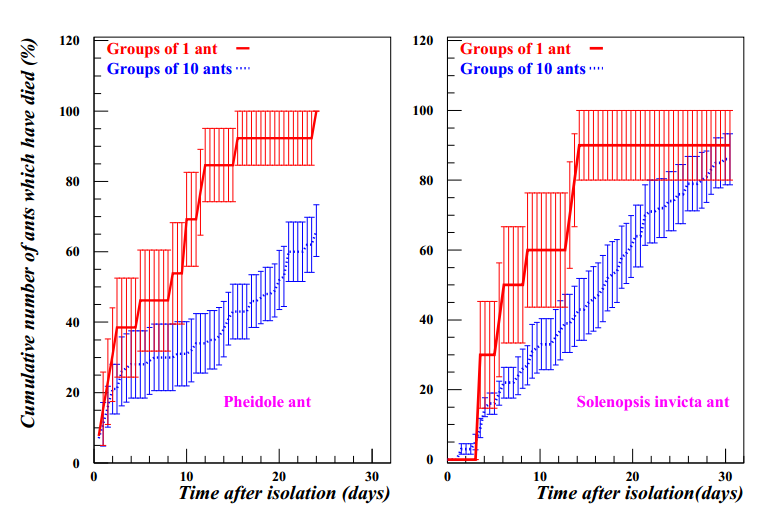Death Test Reveals Strength of Social Interaction
Back in 1993, a team of cell biologists carried out an unusual experiment. These guys measured how the lifespans of cells changed depending on the density of other cells around them.

It turns out that isolated cells die the quickest. They concluded that cells always die unless they get repeated signals from other cells nearby saying “stay alive, stay alive”.
The research has never been followed up and the mechanism at work remains a mystery. But it leaves open a number of interesting questions. Not least of these is whether isolation can also affect the lifespan of other creatures.
Today, Lei Wang at the Red Imported Fire Ants Research Center in Guangzhou, China and a few pals investigate this idea for ants and fruit flies and compare their data with mortality rates for humans who themselves have become isolated.
And their conclusion is startling. They say they can easily measure the reduction in lifespan for isolated ants and fruit flies but they also go further. They say this effect is a measure of the strength of social ties within that species, since creatures with weak social ties are unlikely to be affected much by isolation while those with strong social ties likely to be severely affected.
The experiments are time-consuming but straightforward. These guys took fire ants from a colony in their lab and put them in bowls either individually or in groups of 10. They then waited to see how quickly the ants died and compared this to the average lifespan of ants in the colony.
It turns out that individually isolated ants die quickest, followed by ants in a group of 10 with ants in the colony living the longest at an average of 62 days each. (The experiments took two years in total).
They performed similar experiments with similar results on fruit flies.
Finally, Lei and co compared the results to the mortality data for humans who become isolated when their partner dies. It has long been known that widows or widowers are much more likely to die than those who are married.
However, they point out that this effect is much stronger for younger people than for older people. Lei and co say this is because the social ties between young people, who are generally more recently married, are much stronger than those between people who have been married for a long period of time.
They also threw in the results from a similar experiment done on bees in 1944.
This has allowed Lei and co to rank species according to the strength of their social ties.
They say the fruit flies have the weakest ties, followed by ants, men over the age of 50, men under the age of 50, followed by bees and finally cells, which have the strongest ties.
So the social ties in humans are stronger than those in ants and in fruit flies but weaker than those in bees and in cells.
However, Lei and co are quick to point out that they propose this ranking as a conjecture to stimulate further research.
That’s a curious result that comes from an unusual collaboration between physicists and entomologists.
We’ve looked at previous work from this team in measuring the strength of interaction between creatures using physics-based experiments.
Previous work in this area of social interaction has been Spartan. So it’ll be interesting to see whether this new approach can galvanise others to build on the work.
Ref: arxiv.org/abs/1304.2935: How Does Group Interaction And Its Severance Affect Life Expectancy?
Keep Reading
Most Popular
Large language models can do jaw-dropping things. But nobody knows exactly why.
And that's a problem. Figuring it out is one of the biggest scientific puzzles of our time and a crucial step towards controlling more powerful future models.
How scientists traced a mysterious covid case back to six toilets
When wastewater surveillance turns into a hunt for a single infected individual, the ethics get tricky.
The problem with plug-in hybrids? Their drivers.
Plug-in hybrids are often sold as a transition to EVs, but new data from Europe shows we’re still underestimating the emissions they produce.
Stay connected
Get the latest updates from
MIT Technology Review
Discover special offers, top stories, upcoming events, and more.